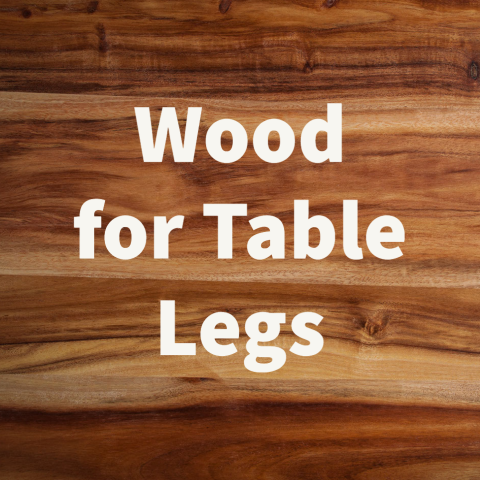Wood is a popular choice for crafting sturdy and aesthetically pleasing table legs. When it comes to selecting the right wood for your table legs, it's important to consider factors such as durability, appearance, and maintenance requirements. In this comprehensive guide, we will explore three common types of wood used for table legs: Parawood, Pine, and Acacia Wood.
Introduction
Table legs play a crucial role in the stability and overall design of a table. They provide support and contribute to the overall aesthetic appeal. Choosing the right wood for table legs is essential to ensure durability, longevity, and visual appeal. Let's delve into the characteristics, pros, and cons of Parawood, Pine, and Acacia Wood to help you make an informed decision.
1. Understanding the Importance of Table Legs
Before we dive into the different types of wood, it's essential to understand the significance of table legs. The table legs not only provide structural support but also determine the style, functionality including stability of a table, and overall appearance of the table. Investing in high-quality wood for table legs ensures stability, longevity, and enhances the beauty of your furniture.
2. Different Types of Wood for Table Legs
2.1 Parawood
Parawood, also known as rubberwood, is a popular choice for table legs due to its sustainability and versatility. Here are some key characteristics and features of Parawood:
- Characteristics and Features: Parawood is light-colored with a tight grain pattern, giving it a clean and contemporary look. It is known for its strength, stability, and resistance to warping or shrinking.
- Pros: Parawood is an eco-friendly choice as it comes from rubber tree plantations. It is readily available and reasonably priced. It takes stain and paint well, allowing for customization options.
- Cons: Parawood can be susceptible to scratches and dents, requiring regular maintenance to keep it looking its best.
2.2 Pine Wood
Pine wood is a popular choice for table legs due to its affordability and natural beauty. Let's explore the characteristics and features of Pine wood:
- Characteristics and Features: Pine wood is known for its warm, rustic appearance and distinct grain patterns. It is lightweight yet durable, making it suitable for various furniture styles. Pine wood often features knots, which add character to the table legs.
- Pros: Pine wood is readily available and cost-effective. It can be easily stained or painted to match your desired aesthetics. It is also known for its natural resistance to shrinking and swelling.
- Cons: Pine wood is softer compared to other hardwoods, making it more susceptible to scratches and dents. It requires proper care and maintenance to preserve its longevity.
- Pine should not be used for painted farmhouse tables. Learn about the disadvantages of using pine for painted tables.
2.3 Acacia Wood
Acacia wood is a popular choice for table legs due to its strength, durability, and unique aesthetics. Here are the key characteristics and features of Acacia wood:
- Characteristics and Features: Acacia wood showcases a rich, natural color with a prominent grain pattern. It has a dense and robust structure, making it highly resistant to wear and tear. Acacia wood often features beautiful variations in color, giving it a distinct and captivating look.
- Pros: Acacia wood is renowned for its exceptional durability, making it suitable for both indoor and outdoor use. It requires minimal maintenance and has a natural resistance to moisture and pests. Acacia wood also offers a unique and eye-catching appearance.
- Cons: Acacia wood can be relatively expensive compared to other wood types. It may require proper sealing or finishing to protect it from prolonged exposure to moisture.
4. Factors to Consider When Choosing Wood for Table Legs
When selecting wood for table legs, several factors should be taken into account to ensure the best choice for your specific needs. Let's explore these factors:
4.1 Durability
Consider the durability of the wood, as table legs need to withstand regular use and potential impact. Some woods, such as Parawood and Acacia wood, are known for their durability and resistance to wear and tear.
4.2 Appearance and Aesthetics
The appearance and aesthetics of the wood play a significant role in the overall design of your table. Each wood type has its unique grain patterns, colors, and textures, allowing you to choose the one that best complements your desired style.
4.3 Maintenance and Care
Consider the maintenance requirements of the wood. Some woods, like Pine, may require more frequent care and maintenance to preserve their beauty and longevity. Others, such as Acacia wood, are naturally resistant to moisture and pests, reducing the need for extensive maintenance.
4.4 Environmental Considerations
If sustainability is a priority for you, consider choosing wood from responsibly managed sources. Look for certifications like the Forest Stewardship Council (FSC) to ensure the wood is harvested sustainably.
5. Comparison of Parawood, Pine, and Acacia Wood
Let's compare Parawood, Pine, and Acacia wood across various aspects to help you make an informed decision:
5.1 Strength and Stability
In terms of strength and stability, Parawood and Acacia wood are known for their robustness, making them suitable for heavy-duty tables. Pine wood, while not as strong, still provides ample support for most table designs.
5.2 Grain Patterns and Texture
Each wood type exhibits its unique grain patterns and textures. Parawood has a tight, uniform grain, while Pine wood showcases distinct knots and swirls. Acacia wood often features an eye-catching interplay of grain patterns, adding to its visual appeal.
5.3 Resistance to Moisture and Humidity
Acacia wood stands out for its natural resistance to moisture and humidity. It is an excellent choice for outdoor tables or areas with high humidity levels. Parawood and Pine wood can withstand moderate moisture but may require additional protection or finishing to prevent damage in humid environments.
5.4 Cost and Availability
When it comes to cost and availability, Pine wood is often the most affordable and widely available option. Parawood is also reasonably priced and easily accessible. Acacia wood, on the other hand, tends to be relatively more expensive and may require a specialized supplier.
Read more via our supplementary blogs:
Parawood: The best wood for table legs
6. Applications and Recommended Use of Each Wood Type
Now that we have explored the characteristics and comparisons of Parawood, Pine, and Acacia wood, let's discuss their applications and recommended use:
- Parawood: Due to its strength and stability, Parawood is suitable for a wide range of table styles, including dining tables, coffee tables, and desks.
- Pine Wood: With its rustic charm and affordability, Pine wood is commonly used for farmhouse-style tables, rustic furniture, and casual dining tables.
- Acacia Wood: Acacia wood's durability and resistance to moisture make it ideal for outdoor tables, patio furniture, and high-traffic areas where strength is crucial.
Consider the specific requirements of your table project and select the wood type that aligns with your desired style and functional needs.
7. How to Care for and Maintain Wood Table Legs
Proper care and maintenance are essential to ensure the longevity and beauty of your wood table legs. Here are some tips to help you care for and maintain them:
7.1 Cleaning and Dusting
Regularly clean your wood table legs using a soft cloth or microfiber duster to remove dust and debris. Avoid using harsh chemicals that can damage the wood's finish.
7.2 Protecting against Moisture and Sunlight
If your table is placed in an area exposed to sunlight or moisture, use coasters, placemats, or tablecloths to protect the wood surface. Apply a protective sealant or finish to shield the wood from water damage.
7.3 Repairing Minor Damages
In case of minor scratches or dents, use wood filler or touch-up markers to repair the damaged areas. Follow up with sanding and refinishing to restore the table leg's appearance.
Conclusion
Choosing the right wood for table legs is crucial to ensure durability, aesthetics, and long-term satisfaction with your furniture. Parawood, Pine, and Acacia wood each offer unique characteristics and advantages. Consider factors such as durability, appearance, maintenance requirements, and your specific needs when making your selection.
By understanding the characteristics and features of Parawood, Pine, and Acacia wood, you can make an informed decision that aligns with your style preferences, functional requirements, and budget.
FAQs (Frequently Asked Questions)
-
Is parawood more durable than pine?
- Parawood is generally considered more durable than Pine wood due to its tighter grain and stability.
-
Can acacia wood be used for outdoor table legs?
- Yes, Acacia wood is an excellent choice for outdoor table legs due to its natural resistance to moisture and durability.
-
How often should I oil or treat wooden table legs?
- The frequency of oiling or treating wooden table legs depends on the specific wood type and environmental conditions. It is generally recommended to follow the manufacturer's guidelines and monitor the wood's appearance for signs of drying or wear.
-
Are there any eco-friendly alternatives to these woods?
- Yes, there are eco-friendly alternatives such as bamboo or reclaimed wood that can be
used as alternatives to Parawood, Pine, and Acacia wood. These options are sustainable and offer unique characteristics suitable for table legs.
- Yes, there are eco-friendly alternatives such as bamboo or reclaimed wood that can be


